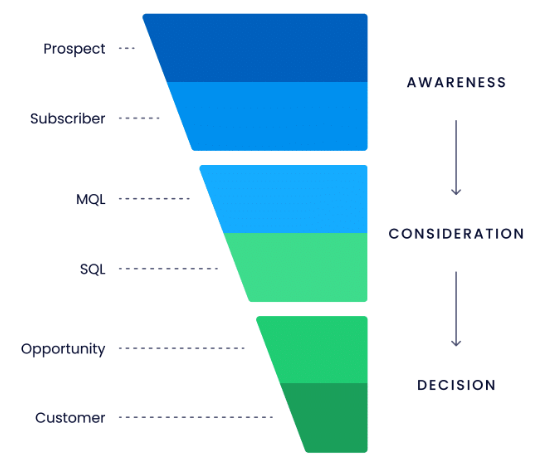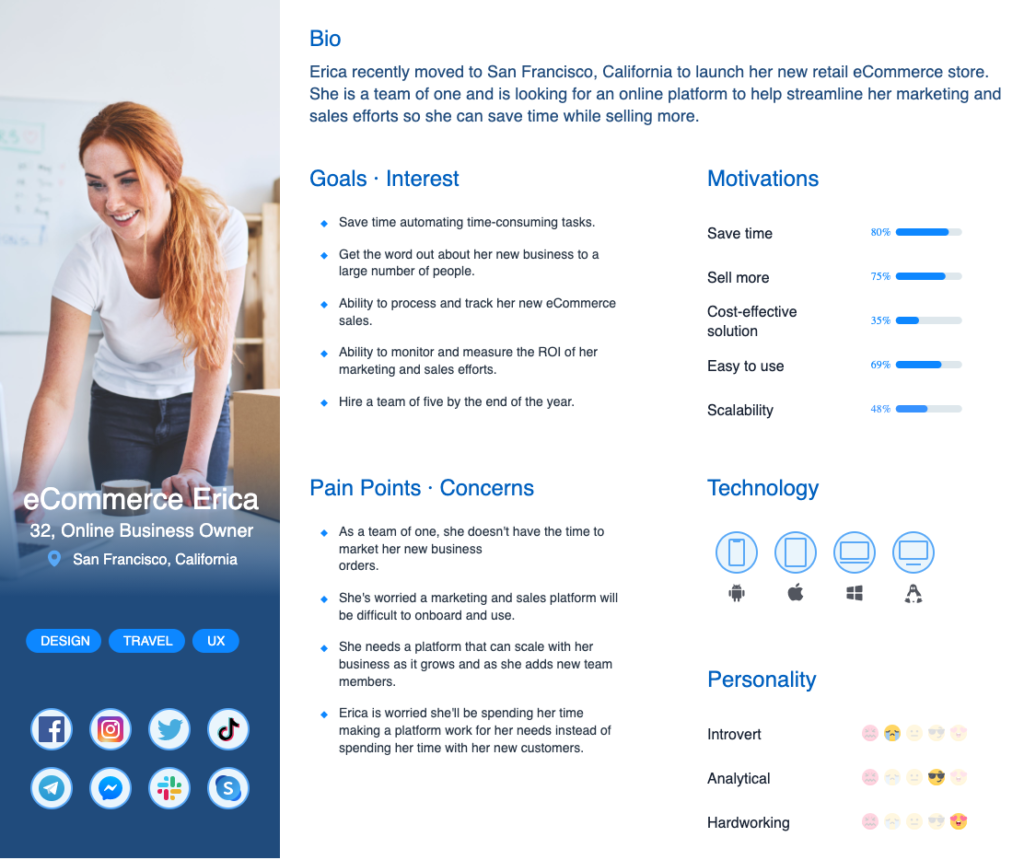The number one reason why business revenue plateaus or declines is due to a misalignment between marketing and sales. Misalignment can cost companies an average of 10% of their annual revenue per year, and can result in loss of productivity and wasted budget. Needless to say, aligning sales and marketing with the right processes and technologies is critical to driving overall company success. When marketing and sales teams are aligned the marketing and sales funnel becomes much more efficient and streamlined, resulting in greater revenue generation, shorter sales cycles, higher close rates and improved forecasting.
Businesses with aligned teams:
- Are 67% more efficient at closing deals
- Achieve 38% higher sales win rates
- See 36% higher customer retention
- Can lead to 209% more revenue
As potential customers engage with your brand and move through the buyer’s journey, it becomes apparent how crucial it is for the sales and marketing teams to be connected throughout the entire process.
Here are the areas where your marketing and sales team should align to ensure company success:
Areas for Marketing and Sales Alignment
1. Define Common Terms
This might seem obvious but according to CSO Insights only 44% of companies have actually formally agreed on what a qualified lead is. While every company may define these terms differently, it’s essential that your marketing and sales teams have the same understanding of the common terms to ensure there’s no disconnect down the road.
Outline the buyer’s journey and define the following terms together. Here are a few examples of what that might look like:

- Prospect
- Ex: Top of funnel. Prospects who have engaged with your business. They have expressed interest beyond initial newsletter sign up, such as downloading an e-book or opening your marketing emails.
- Ex: Top of funnel. Prospects who have engaged with your business. They have expressed interest beyond initial newsletter sign up, such as downloading an e-book or opening your marketing emails.
- Subscriber
- Ex: Top of funnel. Prospects who have engaged with your business. They have expressed interest beyond initial newsletter sign up, such as downloading an e-book or opening your marketing emails.
- Ex: Top of funnel. Prospects who have engaged with your business. They have expressed interest beyond initial newsletter sign up, such as downloading an e-book or opening your marketing emails.
- MQL (Marketing Qualified Lead)
- Ex: Middle of funnel. MQLs are highly engaged with your marketing efforts, indicating interest in your business’s product or service. They have shown a high level of activity, such as downloading multiple resources, interacting with social media posts and/or opening and clicking marketing emails.
- Ex: Middle of funnel. MQLs are highly engaged with your marketing efforts, indicating interest in your business’s product or service. They have shown a high level of activity, such as downloading multiple resources, interacting with social media posts and/or opening and clicking marketing emails.
- SQL (Sales Qualified Lead)
- Ex: Middle of funnel. SQLs have indicated interest in purchasing your business’s product or service, such as requesting to see a demo or filling out your website’s contact form, and are deemed ready for the sales team to reach out personally.
- Ex: Middle of funnel. SQLs have indicated interest in purchasing your business’s product or service, such as requesting to see a demo or filling out your website’s contact form, and are deemed ready for the sales team to reach out personally.
- Opportunity
- Ex: Bottom of funnel. Prospects who are associated with a potential deal. They are a qualified lead and have a high probability of becoming a customer.
- Ex: Bottom of funnel. Prospects who are associated with a potential deal. They are a qualified lead and have a high probability of becoming a customer.
- Customer:
- Ex: Bottom of funnel. Contacts who have at least one closed deal and have purchased your product or service.
2. Define the Roles
Who is responsible for doing what? Create a distinction of handoff between marketing and sales members throughout the buyer’s journey to ensure each stage is accounted for.
Marketing Roles:
- Leads: Create brand awareness and content to generate and qualify leads
- MQLs: Nurture contacts by sending targeted content that defines and compares different solutions
- SQLs: Create solution-based information explaining how your product or service is the best option
Sales Roles:
- SQLs: Reach out to contacts personally to discuss opportunities
- Opportunities: Further qualify leads based on high opportunity vs. low opportunity
- Opportunities: Convert and close deals
- Customers: Build relationships and trust with customers
3. Align Marketing Goals with Sales Goals
When marketing and sales teams are aligned, they are more likely to generate higher quality leads that convert, resulting in greater revenue generation for the business.
If the marketing team’s goal is only focused on generating a high quantity of leads, that means the sales team is receiving poor-quality leads and wasting time not converting leads to customers.
If the sales team’s goal is only focused on converting leads to customers, then they might find it difficult to convert leads who aren’t ready yet.
By aligning the marketing goals with the sales goals, the focus turns into “how can we work together to achieve the main business goal?“ If the main objective of the business is to increase revenue, then the goal of both departments would be to acquire a large number of high- quality leads and to nurture them through the sales funnel, resulting in higher close rates and increased revenue.
To align both teams’ goals with the main business objectives, they should identify the following data together:
- How much revenue is needed
- How many sales are needed
- How many SQLs and MQLs are needed
- How much website traffic is needed
4. Align on Buyer Personas
In order to receive the best ROI from your content, it is imperative that both marketing and sales teams define the buyer personas together. Who is your target audience? What are their challenges and motivations? Using personas to identify your target audience will allow you to determine how to reach them, and what type of content to publish to nurture them down the funnel. Not having clearly defined buyer personas might end up costing you leads, new sales and recurring revenue.

5. Align on Processes
Because of the marketing and sales involvement throughout the entire buyer’s journey it’s important that both teams align on the process. “Businesses with dynamic and adaptable sales and marketing processes have an average of 10% more sales reps hitting their quota compared to other companies.”
How are contacts moving through the funnel in the backend? How will each team member be notified when a contact moves from one stage to another? What are the different CRM properties used to segment and define each contact? These are the types of questions your marketing and sales teams should discuss together to create an understanding of each step in the process, and an easy transition from one team to the other.
Here’s an example of how to articulate each step in your process:
- Ex: What happens when an MQL becomes an SQL?
When an MQL’s lead score is greater than 200 points, the contact is qualified to become an SQL. The contact is automatically entered into the workflow “SQL Deal Card” that creates a deal card, with email and company information attached, within the pipeline. The contact’s life cycle stage is automatically set to Sales Qualified Lead, and an email is set to the sales team to follow-up with the contact within 24 hours.
6. Integrate Platforms
To help keep marketing and sales teams in sync, integrate platforms and CRMs like HubSpot and Salesforce. By doing this, business and client information can automatically sync from one platform to another allowing real-time lead and customer visibility. Both teams can easily share important information such as email opens, resource downloads and page activity between the two platforms to keep the marketing and sales teams aligned. Integrating platforms also allows for easier access to data and detailed reporting so your teams can personalize emails, send targeted emails based on each contact’s interests and buyer’s stage, check how specific marketing efforts translate to sales success and much more.
Streamline Business Growth
By aligning the marketing and sales teams, marketing can start generating more quality leads and the sales team can become more efficient, resulting in higher close rates and therefore more revenue for your business.
Contact Maybank Advisors today for a quick consultation to discover how we can streamline your business process to help accelerate your business revenue generation, or download our free resource, “Digital Strategies to Accelerate Sales and Revenue Growth in 2021,” for some tips on how to get started.







